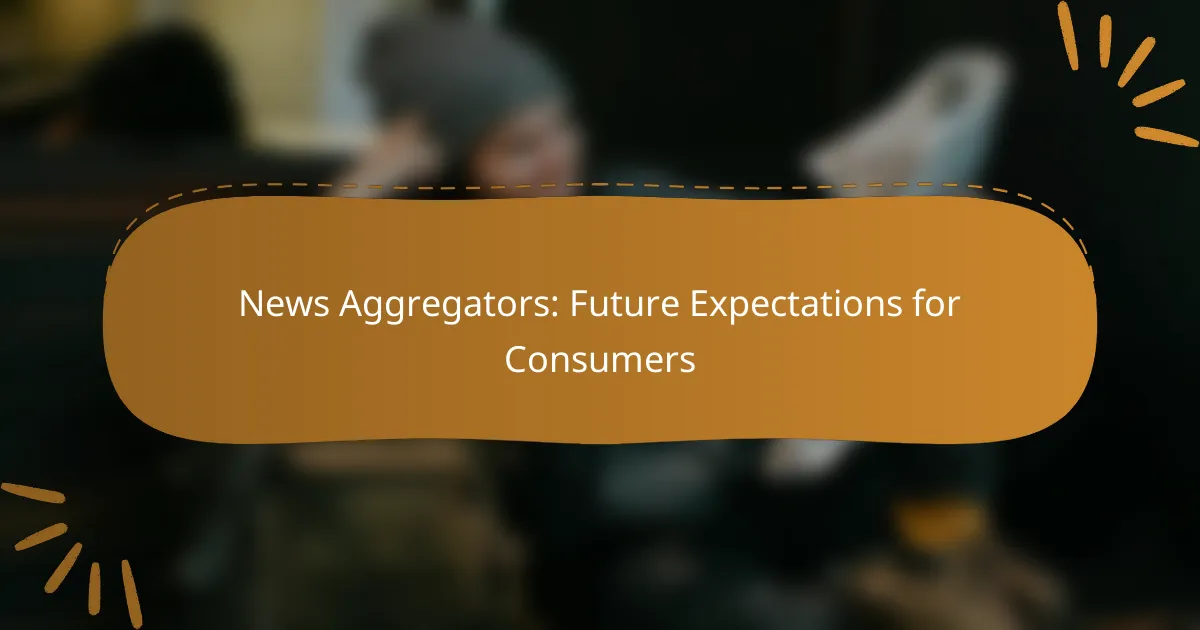The future of news aggregators in the US is set to transform consumer experiences through enhanced personalization and AI-driven content curation. As users increasingly demand tailored news consumption, these platforms will focus on delivering interactive features and seamless access across devices. This evolution aims to meet the growing expectations for minimal advertising and immediate access to diverse news sources, ultimately fostering greater user engagement and satisfaction.
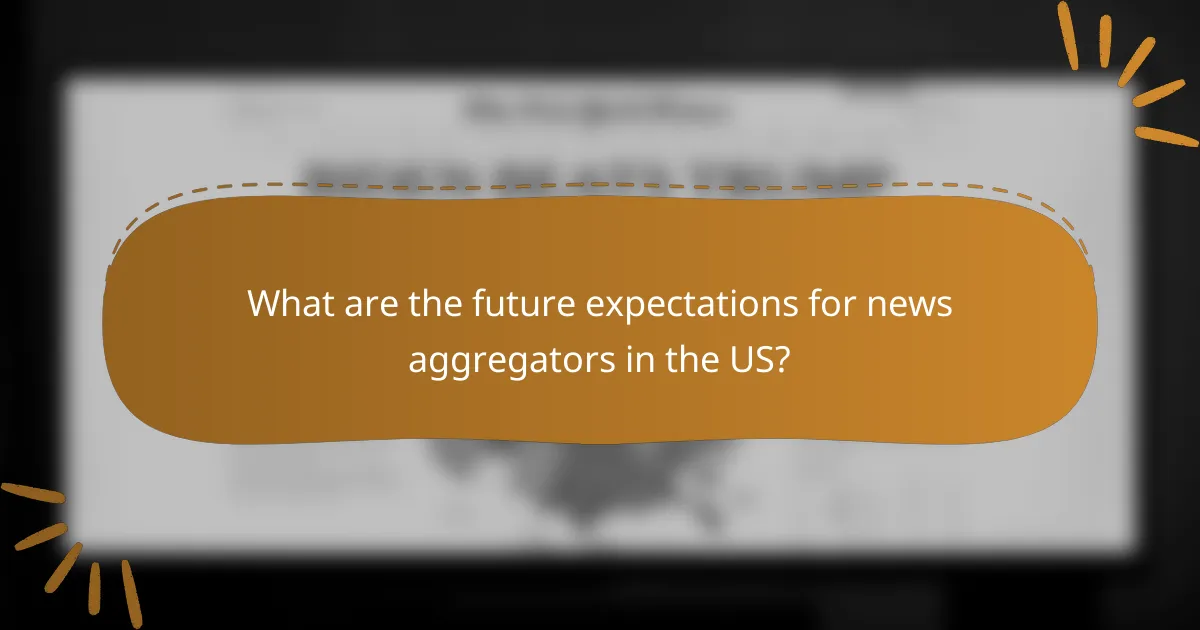
What are the future expectations for news aggregators in the US?
Future expectations for news aggregators in the US include a stronger focus on personalization, the integration of AI for better content curation, and enhanced user engagement through interactive features. These advancements aim to create a more tailored and engaging news consumption experience for users.
Increased personalization features
News aggregators are expected to implement advanced personalization features that cater to individual user preferences. This may include customized news feeds based on reading habits, interests, and location, allowing users to receive content that is most relevant to them.
For example, users might see more articles related to their favorite topics or local news that aligns with their geographical area. This level of personalization can significantly enhance user satisfaction and retention.
Integration of AI for content curation
The integration of AI technology is set to revolutionize content curation in news aggregators. AI algorithms can analyze vast amounts of data to identify trending topics and curate articles that match user interests more effectively than traditional methods.
By utilizing machine learning, these platforms can continuously improve their recommendations based on user interactions, leading to a more dynamic and relevant news experience. This could mean that users receive updates on breaking news faster and with greater accuracy.
Enhanced user engagement through interactive content
Future news aggregators will likely focus on enhancing user engagement by incorporating interactive content. This could include features like polls, quizzes, and comment sections that encourage users to participate actively in discussions around news topics.
Such interactive elements not only make the news consumption experience more engaging but also foster a sense of community among users. For instance, a news aggregator might allow users to vote on the most pressing issues of the day, creating a platform for dialogue and feedback.
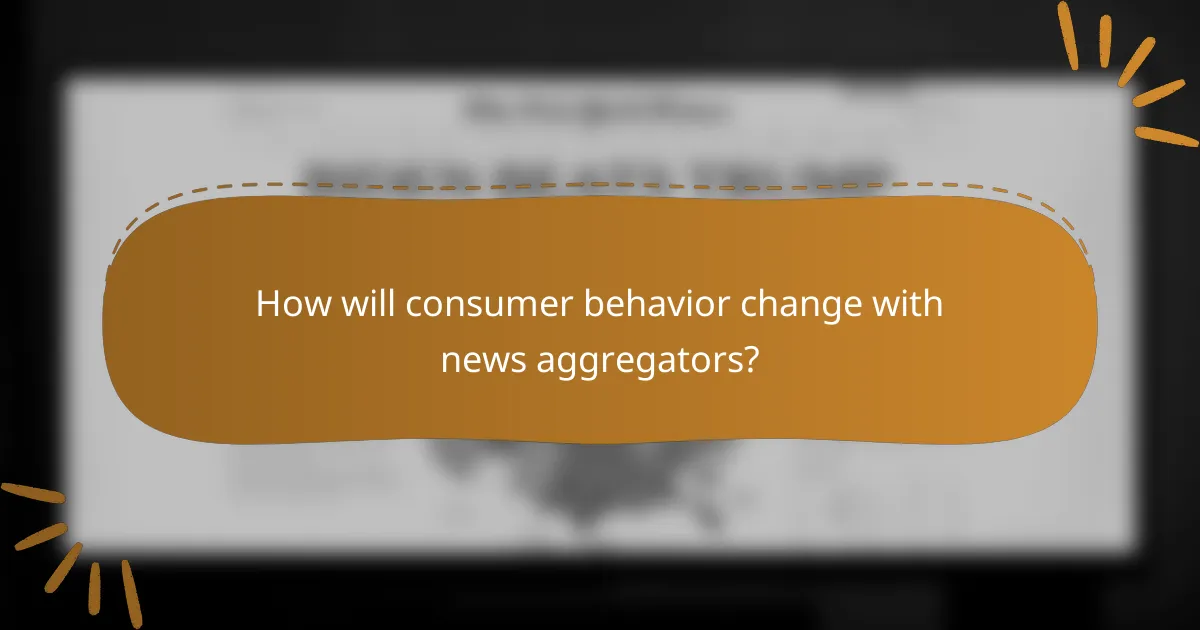
How will consumer behavior change with news aggregators?
Consumer behavior is shifting significantly due to the rise of news aggregators, which streamline access to diverse news sources. As users become accustomed to personalized content, their preferences will evolve towards more tailored and immediate news consumption.
Shift towards mobile consumption
The trend of mobile consumption is growing, with many consumers now relying on smartphones and tablets for news access. This shift means that news aggregators must optimize their platforms for mobile use, ensuring quick loading times and user-friendly interfaces.
For example, apps that provide notifications for breaking news or allow offline reading are becoming increasingly popular. Consumers expect seamless experiences that fit their on-the-go lifestyles, which influences how news is presented and consumed.
Preference for niche content sources
As consumers become more discerning, there is a noticeable preference for niche content sources that cater to specific interests or communities. News aggregators can leverage this by offering curated feeds that highlight specialized topics, such as environmental issues or local events.
This trend encourages users to seek out sources that align with their values and interests, leading to a more engaged readership. Aggregators that facilitate access to these niche sources are likely to see increased user loyalty and satisfaction.
Demand for real-time updates
Consumers are increasingly expecting real-time updates on news events, driven by the fast-paced nature of information dissemination today. News aggregators must adapt by providing timely alerts and live updates, particularly for breaking news or developing stories.
To meet this demand, aggregators can implement features like live blogs or continuous news feeds. Users appreciate platforms that keep them informed as events unfold, making real-time capabilities a critical aspect of modern news consumption.
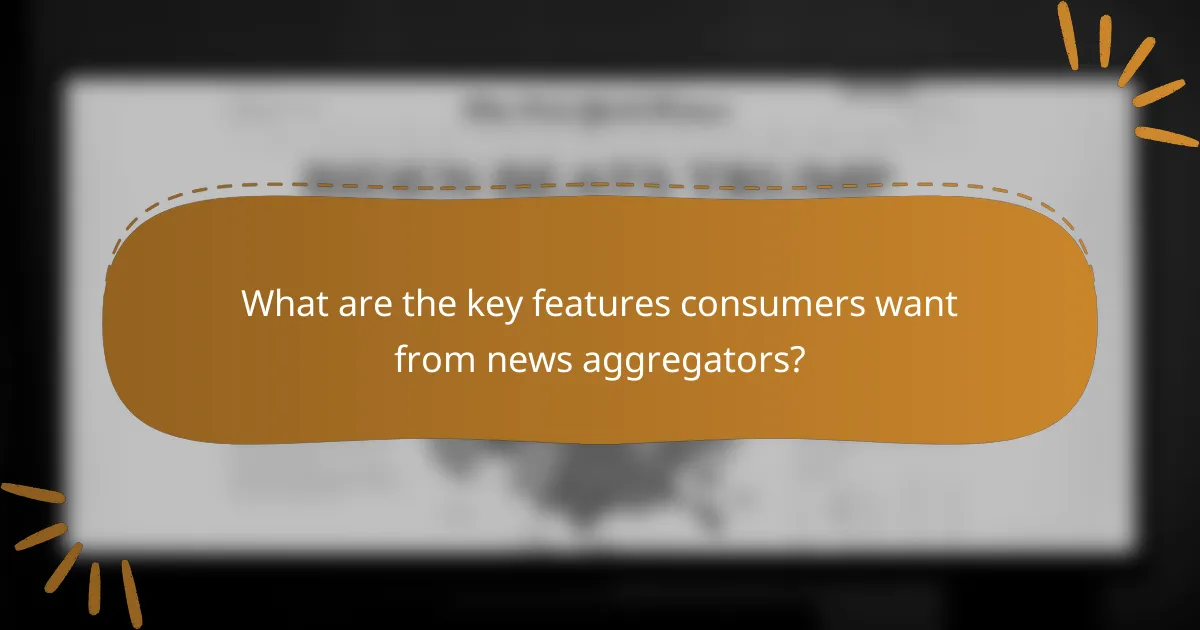
What are the key features consumers want from news aggregators?
Consumers seek news aggregators that offer personalized experiences, minimal advertising, and seamless access across devices. These features enhance user satisfaction and engagement, making it easier to stay informed on topics of interest.
Customizable news feeds
Customizable news feeds allow users to tailor the content they receive based on their interests, preferences, and reading habits. This personalization can include selecting specific topics, sources, or even filtering out unwanted content. For example, a user might prioritize technology news while minimizing sports updates.
When choosing a news aggregator, look for options that offer robust customization features, such as keyword filters or the ability to follow particular journalists or publications. This ensures that your feed remains relevant and engaging.
Ad-free subscription options
Many consumers prefer ad-free subscription options to enhance their reading experience without distractions. These subscriptions typically provide access to premium content and exclusive articles while eliminating advertisements. Pricing for ad-free subscriptions can vary widely, often ranging from a few dollars to around ten dollars per month.
When considering an ad-free option, evaluate the value of the content provided against the subscription cost. Some aggregators may offer trial periods, allowing you to assess whether the investment is worthwhile before committing.
Multi-platform accessibility
Multi-platform accessibility ensures that users can access news aggregators on various devices, including smartphones, tablets, and desktops. This flexibility allows consumers to stay updated on the go, whether they are commuting or at home. Look for aggregators that offer dedicated apps or responsive web designs for optimal usability.
Additionally, consider how well the aggregator syncs across devices. Features such as saved articles or personalized settings should carry over seamlessly, providing a consistent experience regardless of the platform used.

How do news aggregators impact advertising strategies?
News aggregators significantly influence advertising strategies by enabling targeted campaigns and providing valuable consumer insights. Advertisers can leverage these platforms to reach specific audiences based on their interests and behaviors, ultimately enhancing the effectiveness of their marketing efforts.
Targeted advertising opportunities
News aggregators allow advertisers to create highly targeted campaigns by analyzing user preferences and engagement patterns. For instance, an advertiser can focus on users who frequently read technology news, tailoring ads to resonate with that demographic. This precision can lead to higher conversion rates compared to traditional advertising methods.
Additionally, many aggregators offer programmatic advertising options, enabling real-time bidding for ad placements. This means advertisers can adjust their strategies on-the-fly based on performance metrics, ensuring they maximize their return on investment.
Data analytics for consumer insights
Data analytics provided by news aggregators can reveal crucial insights into consumer behavior and preferences. By examining metrics such as click-through rates and time spent on articles, advertisers can better understand what content resonates with their target audience. This information can guide future advertising strategies and content creation.
Moreover, aggregators often compile demographic data, allowing advertisers to segment their audiences more effectively. This segmentation can help in crafting personalized messages that align with the interests and needs of different consumer groups.
Partnerships with content creators
Collaborating with content creators is a strategic move for advertisers using news aggregators. By partnering with influencers or journalists who have established credibility, brands can enhance their visibility and trustworthiness. These partnerships can take the form of sponsored content or co-branded campaigns that leverage the creator’s audience.
Such collaborations not only amplify reach but also provide authentic engagement opportunities. Advertisers should seek out creators whose values align with their brand to ensure a seamless integration that resonates with the audience, ultimately driving better results.

What are the challenges facing news aggregators?
News aggregators face several significant challenges that impact their operations and user experience. Key issues include content copyright disputes, intense competition from social media platforms, and the need to maintain user trust and credibility.
Content copyright issues
Content copyright issues arise when news aggregators use articles or snippets from publishers without proper licensing. This can lead to legal disputes and financial penalties, as publishers seek to protect their intellectual property rights.
To navigate these challenges, aggregators must establish clear agreements with content creators. Many aggregators are now adopting licensing models that compensate publishers fairly, ensuring compliance with copyright laws while providing users with quality content.
Competition from social media platforms
Social media platforms pose a significant threat to news aggregators by offering users instant access to news through feeds and shares. These platforms often prioritize user-generated content, which can overshadow traditional news sources.
To compete effectively, news aggregators should focus on curating high-quality, reliable news and providing unique features such as personalized recommendations or in-depth analysis. Building partnerships with reputable news organizations can also enhance credibility and attract users.
Maintaining user trust and credibility
Maintaining user trust and credibility is crucial for news aggregators, especially in an era of misinformation. Users rely on aggregators to filter out unreliable sources and present accurate news.
To foster trust, aggregators should implement strict editorial standards and transparency about their sourcing methods. Regularly updating users on changes in content policies and actively combating misinformation can also help build a loyal user base.
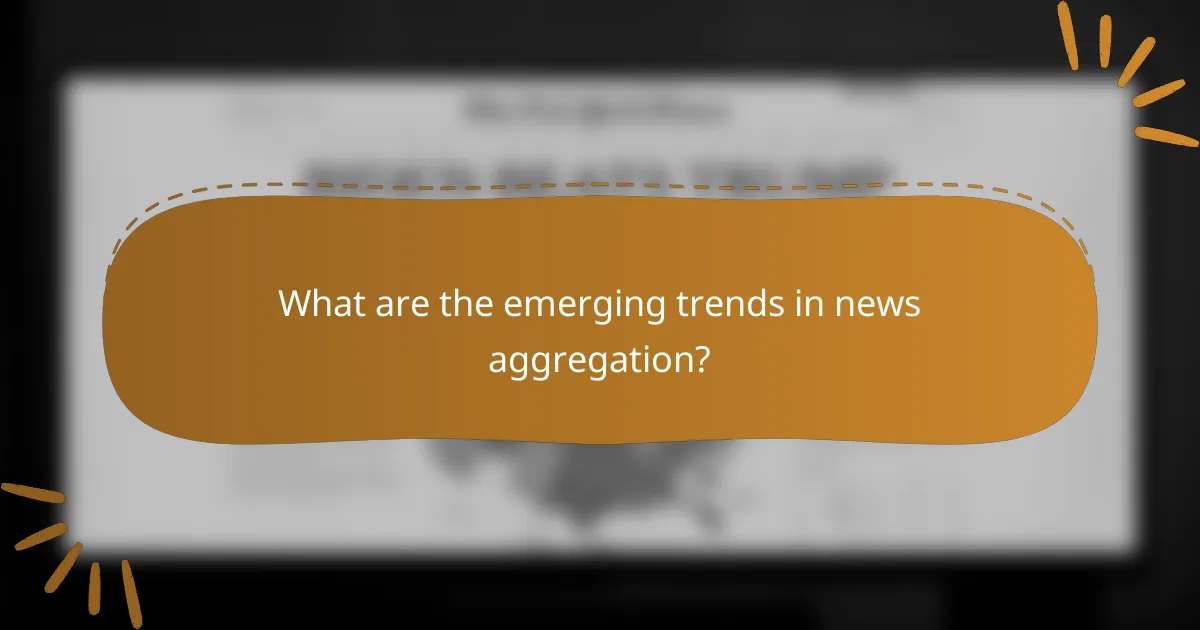
What are the emerging trends in news aggregation?
Emerging trends in news aggregation are reshaping how consumers access information, with a focus on personalization, decentralization, and the integration of artificial intelligence. These trends aim to enhance user experience by providing tailored content while addressing issues of trust and reliability in news sources.
Rise of decentralized news platforms
Decentralized news platforms are gaining traction as they empower users to control their content consumption without relying on traditional media gatekeepers. These platforms utilize blockchain technology and peer-to-peer networks to distribute news, ensuring transparency and reducing the influence of centralized authorities.
For example, platforms like Steemit and Publish0x allow users to earn rewards for creating and curating content, fostering a community-driven approach. This model encourages diverse viewpoints and can lead to a richer news ecosystem, although it may also raise concerns about the quality and reliability of information.
When engaging with decentralized news platforms, consumers should consider the credibility of sources and the potential for misinformation. It’s advisable to cross-reference news from multiple platforms and remain critical of content that lacks verification or transparency in its sourcing.
